United States
Materials from United States of America
Julian Rodriguez Episode One
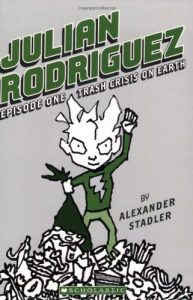 Julian Rodriguez is on a mission for the Mothership. He’s been sent to Earth to study human lifeforms and their bizarre habits–from their disgusting diet (orange sticks named carrots, flavorless liquid called water, and the revolting substance known as vegi-dogs) to their repressive treatment of their young (forcing them to carry out menial tasks known as chores, withholding access to the great cultural masterpieces called cartoons). When Julian’s Maternal Unit assigns a hideous task, it’s nearly too much for the hardened space veteran to bear–but he finds his courage at last. * “First in what readers will hope will be a robust series, this hybrid of fiction and graphic novel dusts off a favorite conceit with a slick swipe of edgy visuals and tart commentary….It’s impossible to read this without laughing.” — Publishers Weekly (starred review)
Julian Rodriguez is on a mission for the Mothership. He’s been sent to Earth to study human lifeforms and their bizarre habits–from their disgusting diet (orange sticks named carrots, flavorless liquid called water, and the revolting substance known as vegi-dogs) to their repressive treatment of their young (forcing them to carry out menial tasks known as chores, withholding access to the great cultural masterpieces called cartoons). When Julian’s Maternal Unit assigns a hideous task, it’s nearly too much for the hardened space veteran to bear–but he finds his courage at last. * “First in what readers will hope will be a robust series, this hybrid of fiction and graphic novel dusts off a favorite conceit with a slick swipe of edgy visuals and tart commentary….It’s impossible to read this without laughing.” — Publishers Weekly (starred review)
Nepantla: Essays from the Land in the Middle
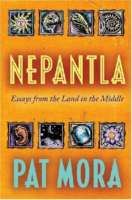
As a Latina educator, poet, mother, lecturer and native of El Paso, Texas, Pat Mora is a denizen of nepantla—a Nahuatl word meaning “the land in the middle.” In her first collection of essays, Mora negotiates the middle land’s many terrains exploring the personal issues and political responsibilities she faces as a woman of color in the United States. She explores both the preservation of her own Mexican American culture and her encounters with other cultures.
Noche de Humo
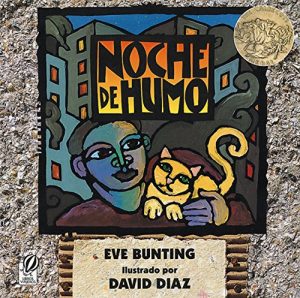 Eve Bunting’s heartfelt story and David Diaz’s dramatic illustrations create a compelling child’s-eye view of urban violence. A young boy and his mother are forced to flee their apartment during a night of rioting in Los Angeles. Fires and looting force neighbors–who have always avoided one another–to come together in the face of danger and concern for their missing pets. David Diaz was awarded the Caldecott Medal for his bold acrylic paint and photo-collage illustrations.
Eve Bunting’s heartfelt story and David Diaz’s dramatic illustrations create a compelling child’s-eye view of urban violence. A young boy and his mother are forced to flee their apartment during a night of rioting in Los Angeles. Fires and looting force neighbors–who have always avoided one another–to come together in the face of danger and concern for their missing pets. David Diaz was awarded the Caldecott Medal for his bold acrylic paint and photo-collage illustrations.
Triple Banana Split Boy / El Nino Goloso
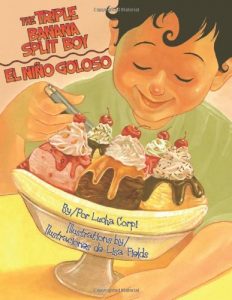 ”How come you can have sweets and I can’t?” Enrique asks the hummingbirds as they flutter over the flowers in the garden. His craving for sugar is getting out of control, and his father has forbidden him to eat anything sweet. Enrique’s birthday is coming up and he won’t be allowed to help his grandma with her baking. It’s not fair! Enrique’s cravings multiply by the minute. Even numbers in his math book start to look like yummy desserts. His life is over! The next day, though, he comes up with an ingenious plan to outwit his father. Unfortunately, his mother soon catches on. But she has a plan of her own. On Mondays and Fridays only, after school, Enrique may have any dessert he likes, but none during the rest of the week. What a sweet deal!On his first outing with his mother, Enrique orders a huge triple banana split, with strawberry, chocolate and vanilla scoops of ice cream, nuts, sprinkles and chocolate syrup. Later that night, Enrique’s stomach aches, and El Coco, a fearsome creature with a huge mouth and sticky hair, haunts his dreams. Enrique’s mother wonders if he will ever learn to eat in moderation. Will he be able to bake with Grandma? And what about having a special treat on his birthday? Lucha Corpi’s poetic prose is combined with Lisa Field’s enticing illustrations in this engaging story that will resonate with kids and their parents as they struggle to balance healthy eating habits with the natural desire for sweets.
”How come you can have sweets and I can’t?” Enrique asks the hummingbirds as they flutter over the flowers in the garden. His craving for sugar is getting out of control, and his father has forbidden him to eat anything sweet. Enrique’s birthday is coming up and he won’t be allowed to help his grandma with her baking. It’s not fair! Enrique’s cravings multiply by the minute. Even numbers in his math book start to look like yummy desserts. His life is over! The next day, though, he comes up with an ingenious plan to outwit his father. Unfortunately, his mother soon catches on. But she has a plan of her own. On Mondays and Fridays only, after school, Enrique may have any dessert he likes, but none during the rest of the week. What a sweet deal!On his first outing with his mother, Enrique orders a huge triple banana split, with strawberry, chocolate and vanilla scoops of ice cream, nuts, sprinkles and chocolate syrup. Later that night, Enrique’s stomach aches, and El Coco, a fearsome creature with a huge mouth and sticky hair, haunts his dreams. Enrique’s mother wonders if he will ever learn to eat in moderation. Will he be able to bake with Grandma? And what about having a special treat on his birthday? Lucha Corpi’s poetic prose is combined with Lisa Field’s enticing illustrations in this engaging story that will resonate with kids and their parents as they struggle to balance healthy eating habits with the natural desire for sweets.
Speak English for Us, Marisol!
After school, Marisol eagerly starts for home to see if her cat, Luisa, has had her kittens. But before she can get there, Uncle Tomás calls to her. He needs Marisol to tell the poultry man that his chickens cost too much. Uncle Tomás cannot speak English so Marisol must do the talking–and she does. Marisol hurries on her way, but soon Auntie Flora stops her for help. Then Mrs. Lopez needs her, too. When Marisol finally gets home, her own mama needs her to hurry to the phone company to straighten out a bill. Luisa will have to wait.
The Big Spanish Heritage Activity Book
This comprehensive activity book for children offers action-packed fun highlighting the contributions of the Hispanic Colonial settlers in the multi-cultural environment of the American Southwest. There are eight sections: The Age of Discovery, The New World, Colonial Life, The Camino Real, The Native Americans, Hispanic Art, Hispanic Architecture, and Hispanic Crafts. Projects are presented in a variety of formats such as illustrations to complete, word searches, matching names and ideas, picture construction, puzzles, and more. This entertaining activity book, richly illustrated by the author, provides a wonderful introduction into the romance and excitement of the Hispanic settlement of America.
N Is for Navidad
Bienvenidos! to a celebration of Christmas, Latino-style! From the ngel (angel) hung above the door to the zapatos (shoes) filled with grass for the wise men s camels, each letter in this festive alphabet introduces children to a Spanish word, and each colorful page takes them through another joyous aspect of the 22 days of the traditional holiday. Vibrant art from acclaimed illustrator Joe Cepeda beautifully complements the lively, rhythmic text to bring the reader a wealth of heritage and a season of light! Feliz Navidad!
Marisol and Magdalena: The Sound of Our Sisterhood
Separated from her best friend in Brooklyn, thirteen-year-old Marisol spends a year with her grandmother in Panama where she secretly searches for her real father.
A Box Full of Kittens
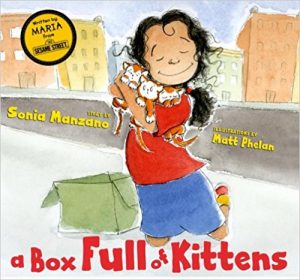 Ruthie loves Superman. Ruthie wants to be Superman. And when Ruthie is asked to go spend the afternoon with her aunt, who is about to have a baby any day day now and may need some help., Ruthie seizes the opportunity. It could be her chance to be a hero, should the baby come while she’s visiting! But when Ruthie is out fetching a snack for her aunt, she gets so distracted by a box full of kittens in the bodega that she doesn’t hear her aunt calling for her, nor does she notice the policemen running to the apartment or the ambulance pulling to the curb. When she realizes what’s happened, she’s devastated — she’s missed her one chance to be a hero! Or has she? Sonia Manzano, best known as “Maria” on Sesame Street, once again captures the warmth, love, and adventures of her childhood Bronx neighborhood.
Ruthie loves Superman. Ruthie wants to be Superman. And when Ruthie is asked to go spend the afternoon with her aunt, who is about to have a baby any day day now and may need some help., Ruthie seizes the opportunity. It could be her chance to be a hero, should the baby come while she’s visiting! But when Ruthie is out fetching a snack for her aunt, she gets so distracted by a box full of kittens in the bodega that she doesn’t hear her aunt calling for her, nor does she notice the policemen running to the apartment or the ambulance pulling to the curb. When she realizes what’s happened, she’s devastated — she’s missed her one chance to be a hero! Or has she? Sonia Manzano, best known as “Maria” on Sesame Street, once again captures the warmth, love, and adventures of her childhood Bronx neighborhood.

